Tuesday, July 17, 2018
The Rough Guide to World Music: Hungary
Simon Broughton introduces the music of Hungary, a country of ten million people with a strong musical profile
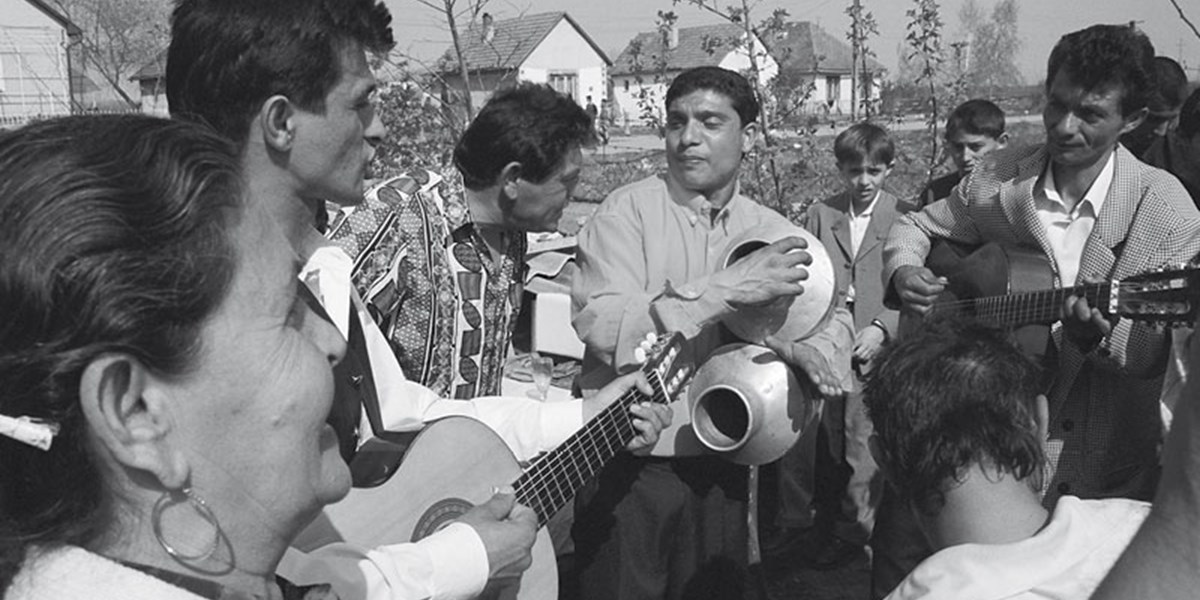
Parno Graszt (Simon Broughton)
Note that this Rough Guide to World Music article has not been updated since it was originally published. To keep up-to-date with the best new music from around the world, subscribe to Songlines magazine.
For a country of ten million people, Hungary has a strong musical profile – two or three world-class composers, the extraordinary “dancehouse” phenomenon which finds traditional music flourishing in the capital and a dynamic Gypsy scene. It all comes down to a statement of identity about who the Hungarians are in the patchwork of Eastern Europe. Simon Broughton tells the story.
Introduction
The fiddler strikes his bow on the string with enough energy to make sparks fly, a musical wizard dispensing his Magyar magic. An accompanying violin and double bass spring into action, sawing away as the dancer begins his routine of high leaps, shoe slapping and intricate footwork. The music is lithe, earthy and full of bite. The sound and the heady atmosphere of red wine and plum brandy makes it easy to ignore the air brick and brieze block walls, and you feel you’re somewhere deep in rural Hungary. In fact, the location is one of several dancehouse (táncház) clubs dotted around Budapest, and you’d be hard pushed to find traditional music of this quality anywhere in the countryside.
Despite its globalized lifestyle, Budapest’s vibrant traditional music scene reinforces a strong national identity. With origins in Siberia, the Magyars, as the Hungarians call themselves, are ethnically distinct from the Slavs and other nationalities that surround them, and their musical mother tongue is something sacrosanct. Though, like the people, the music is now thoroughly “Europeanized”, it remains highly distinctive. In very large part, this is down to the Hungarian language, which is invariably stressed on the first syllable, lending a strongly accented dactylic rhythm to the music. Its infectious sound has been surprisingly influential on neighbouring countries (thanks perhaps to the common Austro-Hungarian history) and it’s not uncommon to hear Hungarian-sounding tunes in Romania, Slovakia and southern Poland.
In Transylvania (Romania) and southern Slovakia there are also large Hungarian minorities where village music is still a living tradition – far more so than in Hungary itself (see Romania article p.324). In these areas the music as well as the mother tongue are crucially important in maintaining that all-important sense of identity. It’s the music of Transylvania first and foremost that fuels the Budapest táncház scene and village musicians from the region are regularly brought over to play.
Bartók, Kodály and Roots East
Béla Vikár started collecting Hungarian folk music as early as 1895 with an Edison phonograph machine, so the composers Béla Bartók and Zoltán Kodály were not the first to systematically investigate the peasant music of Hungary. But they were the most famous and influential. On their collecting trips in the first decade of the twentieth century, they revealed the “real” Hungarian folk music – as opposed to the popular salon tunes played by Gypsy orchestras that were taken to be folk music until then. Both men were fine ethnographers as well as composers, and by using folk material in their own work they not only found their individual voices but brought the folk music to the attention of an international audience. They were also responsible for recognising the Asiatic roots of Hungarian music.
Kodály’s interest was in Hungarian music and the creation of a truly national style. Bartók’s concerns were more international, rooted in the peasant music of all the nationalities of Eastern Europe and beyond. By the time the First World War brought his expeditions in Eastern Europe to an end, he had collected over 3500 Romanian tunes, 3000 Slovak, 2721 Hungarian, plus Ruthenian, Serbian and Bulgarian pieces.
What Bartók and Kodály discovered on their expeditions to remote Hungarian villages was a music that was earthy, fresh and hitherto unknown. More than that, it was distinctly Hungarian and in its oldest layers stretched back to the Magyars’ roots on the fringes of Europe and beyond. Exactly where the Hungarians originated is still debated; but they are not of Indo-European stock like most Europeans, but belong – with the Finns and Estonians – to the Finno-Ugrian linguistic group, whose ancestors lived over 4000 years ago in the Ural region and southwest Siberia.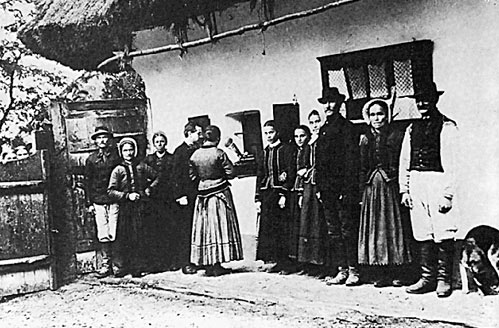
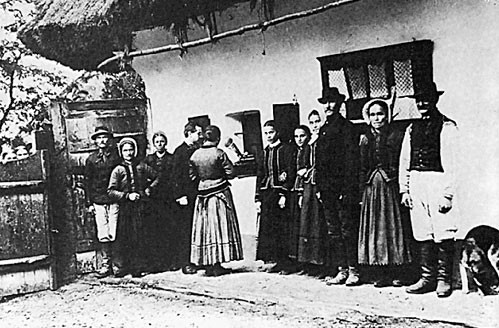
Béla Bartók with his cylinder recorder in 1908 (Hungarotron)
Much research has been done to see if there are musical connections between the Hungarians and Finns but virtually none have been found; not surprising, perhaps, as the tribes are thought to have split around 4000 years ago. Kodály, however, found a link between the oldest Hungarian songs, with their pentatonic (five-note) tunes and descending pattern, and songs of the Mari people, a Finno-Ugrian group who still live close to the ancestral home around the Volga and Kama rivers in Russia. Kodály came up with a substantial number of Hungarian tunes that had direct equivalents in these eastern territories: musical fossils apparently dating back to a shared past 2500 years old. “Time may have wiped away the eastern features from the face of the Magyar community”, he concluded “but in the depths of its soul, where the springs of music lie, there still lives an element of the original east, which links it with peoples whose language it has long ceased to understand, and who are today so different in mind and spirit.”
“New Style” and Gypsy Bands
The Hungarians’ musical history evolved as they settled in the Carpathian basin (around AD 895–902), adopted Christianity (under the canonized King Stephen who ruled from 1000 to 1038) and began to come under the influence of European culture, before Suleyman the Magnificent put a stop to that in 1526 and Hungary endured one hundred and fifty years of Turkish rule. But most of the Hungarian music familiar today has its roots in the eighteenth century when the country rebuilt itself as part of the Hapsburg Empire. The close contact with central European culture brought “new style” music with a regular metric structure for dancing and marching instead of the free speech rhythms of the old style.
Solo bagpipers used to play these tunes for village dances but they were gradually replaced by the new Gypsy orchestras, and the medieval-style drone accompaniment gave way to the central European harmony of the string bands. Just as bagpipes mean Scotland, so Gypsy bands mean Hungary in the popular imagination. When nationalist composers like Liszt composed their Hungarian Dances and Rhapsodies in the latter part of the nineteenth century they took as their models the Magyar Nota music of the urban Gypsy orchestras much as you can hear it in Budapest restaurants today. Most of this repertoire, often showy and sickly sweet, was composed in the nineteenth century.
Following Bartók’s lead, folklorists tend to dismiss this urban Gypsy style in favour of authentic “peasant music”. Yet the music the Gypsies play is no less Hungarian, and it has more in common with peasant music than folklorists may admit. Hungarian folk song was often an influence on popular songs, and even in the remotest parts of the country urban songs have become part of the oral tradition and serve the function of folk songs. In the Transylvanian village of Szék you can still hear a csárdás, which pops up in Brahms’ Hungarian Dances, often cited as prime examples of Gypsy-style fakery.
Gypsies (or more correctly Roma) were first recorded in Hungary in the fourteenth century, and the country’s Gypsy musicians became famous from the eighteenth century on. “The Hungarian has a musical score which can compete with that of any nation … This score lives and travels in the form of the Hungarian Gypsy”, wrote one observer in 1858. Most of the early Gypsy bands seem to have been located in western Hungary and were often invited to perform at aristocratic celebrations.
In addition to society gigs, the Gypsies also performed at recruiting ceremonies where young lads were enticed into the army with verbunkos music (from werbung – the German word meaning “recruit”). The Hapsburgs only introduced universal conscription in 1868, so before that the men were lured with dancing, music and the promise of a carefree life. Verbunkos music is strongly rhythmic, consisting of a slow dance followed by a fast one. The steps were developed from the showy men’s dances of the village. Probably the most famous verbunkos tune is the “Rákóczi Song”, which later evolved into the “Rákóczi March” – featured in compositions by Berlioz and Liszt.
The Hungarians, always searching for a musical identity, found it in the verbunkos music and it typified the Hungarians abroad. A German officer saw the dance in 1792: “It expresses the character of the nation in an extraordinary way. The true Hungarian dances have to begin really slowly and then continue faster. They are much more becoming to a serious moustached face than to a young lad no matter what forced capers they do. The whole art of the dancer is to be seen in the artistic movement of his legs and the rhythmic clicking of his spurs.” The slow and fast dances of verbunkos music have been seen as the two contrasting aspects of the Hungarian character and in the nineteenth century, Liszt felt unequivocally that the Gypsies were Hungary’s national musicians and verbunkos was the inspiration for his Hungarian Rhapsodies.
Amongst the most celebrated Gypsy performers of the “golden age” were the female primás (lead violinist) Czinka Panna (1711–72) and Gypsy musicians from the town of Galánta – both celebrated in pieces by Kodály. The most famous Gypsy band leader was János Bihari, born in 1764 and known as the Napoleon of the fiddle! “Like drops of some fiery spirit essence, the notes of this magic violin came to our ears”, wrote Liszt. Bihari’s band usually consisted of four strings plus a cimbalom, the hammered dulcimer so common in Gypsy bands.
The most celebrated fiddlers now playing in this style come from the Lakatos family – notably Sándor Lakatos and his nephew, the young Roby Lakatos – said to be direct descendants of Bihari himself. Their repertoire is essentially the light classical music of Liszt, Brahms and Monti’s Csárdás played with a showy verve and abandon. There is lots of exaggerated rubato and up-front virtuosity. More slickness than soul, but technically very impressive.
Sadly these days in Hungary it is very hard to find real village music in the way Bartók and Kodály did. The music was already disappearing in the early years of the twentieth-century although it persisted up to the 1960s and beyond. Today, the best areas to try – at traditional weddings and similar affairs – are Szabolcs-Szatmár county, out on a limb in the northeast, and southwest Transdanubia in the south of the country bordering Croatia. Fonó Records, who have released the much-acclaimed Final Hour series of Transylvanian bands have recent recordings of various Hungarian village bands waiting for release.
A more fixed event, with a guarantee of music-making, is Busójárás Carnival in Mohács at the beginning of March. The music played in Mohács is basically Serbian and Croatian. The celebrated Bogyiszló orchestra was until recently the best in the region but is, alas, no longer active.
There’s also a rich tradition of Serbian music from the communities in Szentendre and Pomaz north of Budapest where the excellent group Vujicsics is based.
Gypsy Folk
So if the music played by Hungary’s ubiquitous Gypsy bands is Hungarian, what’s the Gypsy music? Oddly enough, considering the number of Gypsy instrumentalists, the music of the Roma themselves hardly uses instruments at all. Most of the Romungro Gypsy musicians who play in the urban bands don’t actually live amongst the (poorer) Gypsy communities and generally play for non-Gypsy audiences. Their music is professionally composed and urban in style. But there’s a contrasting style of rural Gypsy music played by the Vlach (or Olah) Gypsies, horse-traders and travelling salesmen, who came to Hungary from Romania in the nineteenth century when slavery was abolished. In recent years, their music has proved the most dynamic on the Hungarian music scene.
Traditionally, this rural Gypsy music had no swooning violins, but was accompanied by rhythmic grunts, the tapping of domestic utensils like spoons and water cans and imitations of instruments in a “doobie-doobie-doobie” sort of way called “oral-bassing”. It oscillates between tragic songs about the hardships of Gypsy life and wild, upbeat numbers throwing all cares to the wind. The music was not intended for others and was only performed at Roma gatherings or celebrations until professional bands appeared in the 1970s. Parno Graszt (Romani for White Horse) is a real village band from Paszab in northeast Hungary that has made excellent recordings and played a few festivals. Led by guitarist and tambura player József Olah, they combine a rough authenticity with a musical professionalism that makes them quite unique.
Kalyi Jag (Romani for Black Fire) was the first of the Hungarian Roma groups to present their music on stage in 1978. They added guitars and other instruments to the powerful vocals of Gusztáv Varga and József Balogh and are still going strong. They’ve been followed by bands like Ando Drom (On the Road), with the extraordinary singer Mitsoura who’s now gone solo, and Rományi Rotá (Gypsy Wheel) who have a regular táncház in Budapest. There are often concerts by these bands in the atmospheric Roma Parlament in the heart of Pest’s Gypsy neighbourhood in the eighth district.
The most interesting group of late is Romano Drom (see box opposite), formed around the father and son Antal “Gojma” Kovács and Antal “Anti” Kovács Jr. Their basic vocal, percussion and guitars line-up is augmented by guest musicians on saxophone, accordion and violin and recently the female singer Matild Dobi. They’re also involved in the Gypsy club scene, a new feature of Budapest nightlife. Romano Drom’s music was remixed by various producers and DJs on the Romano Trip album. The Roma rap scene has also taken off in recent years, pioneered by Fekete Vonat (Black Train). Their name comes from the train (no longer running) which took migrant Gypsy workers from the deprived northeast to jobs in Budapest. (See the chapter on Gypsy Music, p.196, for the wider context of Roma music in Eastern Europe.)
The Táncház
The Hungarian capital Budapest is one of the best places in Europe to hear really good folk music, and the place to go is a táncház – literally a “dance house” named after traditional village dancing places (see box below). The atmosphere at a táncház is a cross between a barn dance and a folk club but without the self-conscious folksiness of its Western counterparts. The dress may be blue jeans and trainers with the odd Transylvanian jacket or skirt, but for the most part the clientele – teachers, doctors, lawyers – know the music and can dance to it well. Once again this is a statement of identity. Blue jeans are the same the world over, but this music and dance comes with a Hungarian designer label.
The táncház movement started in the 1970s as a reaction to the regimented folklore of the state ensembles. Following in the footsteps of Bartók and Kodály, musicians like Ferenc Sebő and Béla Halmos collected music from the villages, learned it and brought it back to Budapest. But whereas Bartók and Kodály had been interested mainly in songs, this new generation was interested in the instrumental music and traditional dances – György Martin and Sándor Tímár were the principal dance researchers. The idea was to bring the music back to the grassroots rather than present it on stage and, despite the urban setting, keep it closer to its original form.
Even though it had virtually no official support, the movement grew from strength to strength. For many years it also had a political dimension. The wellspring of Hungarian táncház music was in neighbouring Romania where the Hungarian minority of Transylvania has kept a living folk tradition to this day (see Romania article, p.324). Táncház musicians often travelled there in very difficult circumstances to collect music and dances. Since the fall of Communism there’s been a regular flow of great Transylvanian village performers to the táncház of Budapest bringing a welcome rough-edged note of authenticity.
Táncház music falls into two types. One is music from Hungary proper which, with less of a living tradition, has usually been learned from archive recordings or written collections and arranged by the groups in the manner of folk bands all over Europe. But the most popular music comes directly from the village tradition and that means Transylvania (or occasionally the Hungarian communities in Slovakia). The basic instrumental line-up is a lead fiddle, an accompanying violin (kontra) playing chords and a bowed bass – there’s often a cimbalom included as well. If at first the tunes all sound similar, keep listening. The better you know this music the more rich and varied it becomes. In the right hands it has a beauty unrivalled in Europe.
Táncház dances are played in sets, generally moving from slower tempos to fast – beginning perhaps with a verbunkos or Lad’s Dance, giving the chance for the men to show off, and ending with a fast and furious csárdás. It’s the prímás, the first violinist of the band, who keeps an eye on the dancers and judges when to make the move and tempo change into the next dance. When it’s done well it’s thrilling.
The csárdás is the most famous Hungarian dance tune and you won’t spend five minutes at a Budapest táncház (or a Transylvanian wedding) without hearing one. They can be fast or slow, “whirling”, “quivering” or “leaping” – and there are all sorts of regional variations. All of them are couple dances which can reach great virtuosity, but at their most basic it’s two steps left, two steps right followed by a turn. The music has a regular four-square rhythm with a distinctive spring.
Internationally, the best-known names in Hungarian music emerged from the táncház scene: Márta Sebestyén (see box), a truly remarkable singer (and not just of Hungarian music) and Muzsikás, one of the first of the dancehouse groups. As a band they have succeeded in keeping the fine balance between a professional approach on stage and the raw gutsy sound of the village. They have explored the links between Kodály and Bartók’s music and the authentic village tradition and they remain the leading ambassadors of traditional Hungarian folk music.
Other top musicians to watch out for include fiddler Csaba Ökrös and his ensemble, and the Tükrös, Téka and Kalamajka groups who specialize in Hungarian and Transylvanian repertoire. Other notable singers are Kati Szvorák, Beáta Palya and András Berecz. Muzsikás have also introduced the Moldavian singer Mária Petrás.
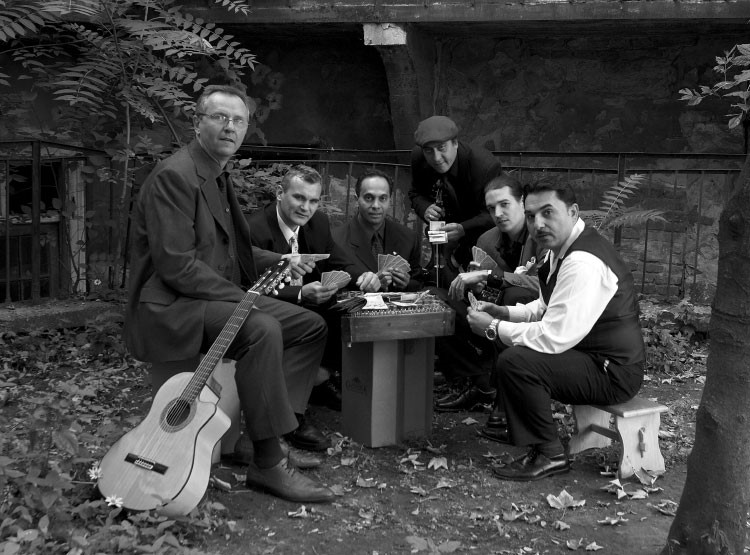
Kálmán Balogh and the Gypsy Cimbalom Band
The virtuoso Gypsy cimbalom player Kálmán Balogh frequently collaborates with many of these musicians and also draws on wider influences from Balkan, Latin and American music. Makám, with a wide variety of eastern European and “world” instruments, are a stimulating ensemble pushing the music in a classical, chamber-style direction with the excellent singer Irén Lovász.
Clarinettist, saxophonist and cimbalom player Mihály Dresch pursues a much more experimental line in a jazz/folk quartet with violin, bass and percussion which probably doesn’t do a lot for the dancers in the táncház, but appeals to another clientele. The young virtuoso violinist Félix Lajkó (a Hungarian from Subotica in Serbia) is classically trained, but with his group Zenekara plays rhythmic and infectious concert music drawing on Hungarian, Balkan and Middle-Eastern traditions. Great playing and definitely a name to watch out for.
Márta Sebestyén and Muzsikás
“People think that folk music is for old situations”, says Márta Sebestyén. “I think that’s rubbish because the basic human and emotional situations are still the same. My duty is to bring this music closer to people in an emotional way. You can’t say you have to respect this music of your ancestors – people shit on that. But if it touches the heart it will be remembered forever.” Márta’s organic, natural voice has an uncanny power to captivate – her performance of “Szerelem, Szerelem”, an old Transylvanian love song, entranced the fictional Hungarian count played by Ralph Fiennes in The English Patient, but also audiences across the globe. In Hungary she’s received many awards, she dined with the Blairs at number 10, and counts Prince Charles amongst her admirers. But actually it’s in communication with ordinary people, both in learning the songs and transmitting them, that her real skill lies. “I love to hear these old ladies sing”, she explains. “Their voices are like delicate lace. They put their lives into their songs and I can remember every nuance, every ornamentation in the voice.”
Márta was born into a musical environment. Her mother was an energetic musical teacher and pupil of Zoltán Kodály. According to her, Márta could sing before she could talk. At school she won folk singing competitions every year and in the early 1970s got involved with the “dancehouse” movement that was just taking off. Márta performed with Ferenc Sebő and Béla Halmos, two of the táncház pioneers, and for many years sang with Muzsikás, Hungary’s leading group on the international circuit. Márta’s voice cutting through the swirling violins and sawing bass of traditional Transylvanian repertoire is hard to beat, although now she’s exploring new directions.
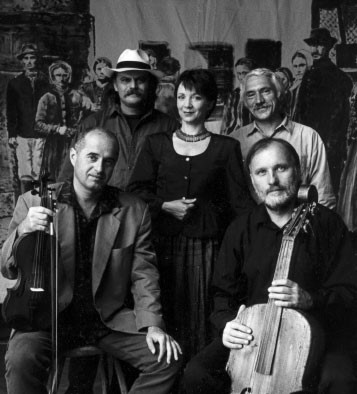
Márta Sebestyén and Muzsikás (Béla Kása)
Music and dance are inseparable. “If you don’t know the feeling of the dance you can’t make a good accompaniment for the dancers”, says Muzsikás’ bass player Daniel Hamar. “You have to know the music from the inside.” It certainly makes their music feel natural and they keep close contact with the traditional sources, where sometimes the music isn’t appreciated enough. In the Transylvanian village of Szászcsávás (Ceuas), Muzsikás decided to help.
“The Szászcsávás band has played in Europe and America and had big success”, explains Hamar. “Everybody knew this, except the local people who just got resentful when their Gypsy musicians come home with more spending money. So we decided to make a concert there with technical quality as good as anywhere else in the world. We took a top-quality PA, modern lights and printed full-colour posters. We were the stars, of course, because they’d seen us on television. But after half an hour I said to the audience that we’d like to invite on stage some of the best musicians we’ve ever heard. And we invited the local musicians to play. It was the first time the village had seen their local musicians as stars and the reaction was fantastic.”
Since their Bartók Album of 1999, Muzsikás have been introducing traditional music to classical music audiences and vice versa. “Some of Bartók’s pieces include direct quotations of folk melodies”, says Hamar. “But the spirit of folk music is there even in his most abstract pieces. For example, in the String Quartets there are no actual folk melodies, but we can feel their emotions. Bartók himself said that it was the expressiveness and feeling inherent in traditional music that inspired him to use it.”
On the Bartók Album Muzsikás worked with the classically-trained violinist Alexander Balanescu and on tour in the US with the Takács Quartet. Approaching Bartók after thirty years of playing traditional music gives them a new approach and both Balanescu and Takács say they play differently since their collaborations with Muzsikás. “When we did our concert with the Takács Quartet in Carnegie Hall all eight of us felt that it was one music we were creating together”, says Hamar. “It was like the traditional music created an energy which the string quartet took over. We interleaved our music between the movements of the 4th Quartet which had to be done very carefully to maintain the symmetry of the piece. But it was truly something special and we felt that if Béla Bartók had been able to hear it he’d have been very happy. At the end of his life he lived just a couple of blocks from Carnegie Hall.”
“I respect Béla Bartók enormously”, continues Hamar, “but in one thing he was not right. In 1928 he said that it was the last moment and that within a few years traditional music would die out. But in fact it has proved to be much stronger. The old musicians die and suddenly there’s a young player who takes over and plays in exactly the same way. It’s a fantastic thing. Whether it will still be there in 25 years I don’t know, but I hope this music can find its new function in this new life. We have given it a chance because we can prove that this music is not only acceptable at a wedding in Transylvania, but in Carnegie Hall or a club in Budapest.”
One of the most exciting groups in Hungary specializes in fusing Serbian and Croatian tambura music. Vujicsics is based just north of Budapest amongst the south Slav communities in Szentendre and Pomaz. And, as Hungary has the largest Jewish community in Eastern Europe, it’s no surprise that there are fine klezmer groups – the Budapest Klezmer Band and notably Di Naye Kapelye who really marry the Jewish and the táncház tradition to explore little-known rural repertoire.

